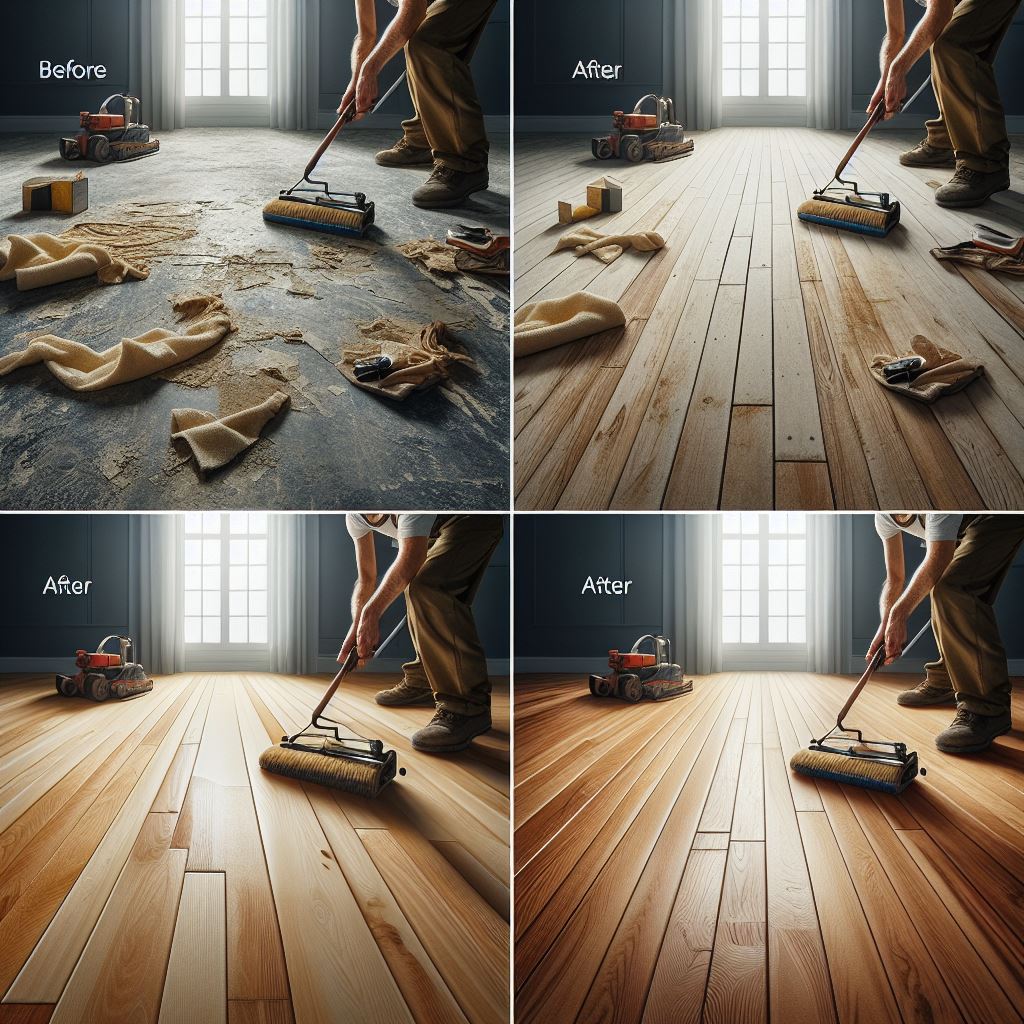When it comes to choosing the perfect flooring for your home, the options can seem endless. One option that has been gaining popularity over the years is pre engineered wood flooring. But what is pre engineered wood flooring exactly? Unlike traditional hardwood flooring, pre engineered wood flooring is constructed from multiple layers of wood, with a genuine hardwood veneer on top. This design makes it not only more durable but also more versatile in terms of installation.
The concept behind pre engineered wood flooring is to provide the aesthetic and feel of traditional hardwood while offering enhanced stability and resistance to moisture and temperature changes. The core layers are typically made from plywood, high-density fiberboard (HDF), or hardwood, which provides a stable base for the top hardwood layer. This construction method allows for a thinner top layer of high-quality hardwood, making it more cost-effective without sacrificing appearance.
Curious about how pre engineered wood flooring can transform your space? Request a free estimate or email us at sales@paradise-spaces.com for personalized advice and options that suit your specific needs.
Benefits of Pre Engineered Wood Flooring

When considering flooring options, it's essential to weigh the benefits of each type. Pre engineered wood flooring offers a multitude of advantages that make it an attractive choice for homeowners.
1. Durability and Stability: The multi-layer construction of pre engineered wood flooring provides exceptional stability, making it less prone to warping or bowing due to changes in humidity and temperature. This makes it ideal for areas that experience varying climate conditions.
2. Aesthetic Appeal: With a top layer made of real hardwood, pre engineered wood flooring offers the same rich, warm look and feel of traditional hardwood. It comes in a variety of wood species, finishes, and stains, allowing you to customize the look to match your interior decor.
3. Easy Installation: One of the standout features of pre engineered wood flooring is its ease of installation. It can be installed using a variety of methods, including floating, glue-down, or staple-down, making it a versatile option for various subfloor types.
4. Cost-Effective: While still offering the luxurious appearance of solid hardwood, pre engineered wood flooring is generally more affordable. Its efficient use of materials means you get the beauty of hardwood without the high price tag.
5. Eco-Friendly: The construction process of pre engineered wood flooring uses less hardwood compared to traditional solid wood floors, making it a more environmentally friendly choice. Additionally, many manufacturers use sustainable practices and materials in their production processes.
Overall, pre engineered wood flooring combines the best of both worlds: the beauty and elegance of hardwood and the practical benefits of modern engineering. Whether you're renovating a single room or an entire home, it's a choice that offers lasting value and style.
Construction of Pre Engineered Wood Flooring
Understanding the construction of pre engineered wood flooring is key to appreciating its durability and versatility. Unlike traditional solid wood flooring, pre engineered wood flooring is composed of multiple layers, each serving a specific purpose.
1. Top Layer: The visible surface layer, also known as the wear layer, is made of real hardwood. This layer can be crafted from a variety of wood species, such as oak, maple, or walnut. The thickness of this layer can vary, but it typically ranges from 2mm to 6mm. A thicker wear layer allows for multiple refinishing, extending the floor's lifespan.
2. Core Layers: Beneath the top layer are several core layers, usually constructed from high-density plywood or hardwood. These layers are arranged in a cross-grain configuration, which provides enhanced stability and resistance to environmental changes such as humidity and temperature fluctuations. This construction technique significantly reduces the risk of warping or swelling, common issues with solid hardwood floors.
3. Backing Layer: The bottom layer, or backing layer, is designed to provide additional stability and support. It is typically made from the same material as the core layers, ensuring a balanced structure. This layer helps to prevent moisture from penetrating the flooring from below, adding to the overall durability.
The multi-layered construction of pre engineered wood flooring makes it a highly stable and reliable flooring option. Each layer is meticulously designed to work together, resulting in a product that not only looks stunning but also withstands the rigors of everyday use. Whether installed in a residential or commercial setting, pre engineered wood flooring delivers on both form and function.
Installation Process of Pre Engineered Wood Flooring

The installation process of pre engineered wood flooring is designed to be simpler and more straightforward compared to traditional hardwood floors. This ease of installation is one of the reasons why it has become a popular choice among homeowners and contractors alike.
1. Preparation: The first step in the installation process is to prepare the subfloor. The subfloor must be clean, dry, and level to ensure optimal results. Any irregularities should be addressed before proceeding with the installation.
2. Acclimation: Pre engineered wood flooring needs to acclimate to the room's temperature and humidity levels. This typically involves leaving the flooring materials in the installation area for at least 48 hours. This step is crucial to prevent any expansion or contraction after installation.
3. Underlayment: An underlayment is often used to provide a moisture barrier and additional sound insulation. This layer is rolled out over the subfloor before the planks are laid down. The type of underlayment can vary depending on the specific needs of the installation site.
4. Installation Methods: There are several methods to install pre engineered wood flooring, including:
- Floating: The planks are snapped together using a tongue-and-groove system and float over the underlayment without being attached to the subfloor. This method is quick and ideal for DIY installations.
- Glue-Down: Adhesive is applied to the subfloor, and the planks are laid directly onto it. This method provides a more permanent installation and is often used in commercial settings.
- Staple or Nail-Down: The planks are fastened to the subfloor using staples or nails. This method is typically used for installations over a wooden subfloor.
5. Finishing Touches: Once the flooring is installed, the final step involves adding baseboards or molding to cover the expansion gaps around the room's perimeter. This not only provides a polished look but also allows the floor to expand and contract naturally.
By following these steps, you can achieve a professional-looking installation that enhances the beauty and functionality of your space. Whether you opt for a DIY approach or hire a professional, the process is designed to be efficient and effective, ensuring lasting results.
Maintenance Tips for Pre Engineered Wood Flooring

Maintaining pre engineered wood flooring is relatively straightforward, but it does require some routine care to keep it looking its best. Here are some essential maintenance tips to ensure the longevity and beauty of your flooring:
1. Regular Cleaning: Dust and dirt can act like sandpaper on your floor's finish, so it's important to sweep or vacuum regularly. Use a soft-bristled broom or a vacuum with a hardwood floor attachment to avoid scratching the surface.
2. Use Appropriate Cleaners: Always use cleaners specifically designed for wood floors. Avoid using harsh chemicals, abrasive cleaners, or steam mops, as these can damage the finish. A damp mop with a pH-neutral cleaner is usually sufficient for routine cleaning.
3. Protect from Water: While pre engineered wood flooring is more resistant to moisture than traditional hardwood, it's still important to wipe up spills immediately. Use mats or rugs in areas prone to water exposure, such as near sinks or entryways, to provide an extra layer of protection.
4. Prevent Scratches: Place felt pads under furniture legs to prevent scratches and dents. Be cautious when moving furniture, and lift rather than drag items across the floor. Additionally, consider using area rugs in high-traffic areas to minimize wear and tear.
5. Monitor Humidity Levels: Wood is sensitive to changes in humidity. Use a humidifier during dry seasons and a dehumidifier during humid seasons to maintain a stable environment. Ideally, indoor humidity should be kept between 30% and 50%.
6. Refinish When Necessary: Although pre engineered wood floors are durable, they may eventually show signs of wear. Some types can be lightly sanded and refinished to restore their appearance. Consult the manufacturer's guidelines to determine if your flooring can be refinished and the recommended process.
By following these maintenance tips, you can ensure that your pre engineered wood flooring remains beautiful and functional for years to come. Regular care not only enhances the aesthetic appeal of your floors but also extends their lifespan, making it a worthwhile investment for any home.
Comparing Pre Engineered Wood to Traditional Hardwood

When deciding between pre engineered wood flooring and traditional hardwood, it's essential to consider various factors such as cost, durability, and installation. Both options offer unique advantages and a few drawbacks, making it important to evaluate which best suits your needs.
Cost: Pre engineered wood flooring is typically more affordable than traditional hardwood. The manufacturing process and the use of a plywood or HDF core reduce the cost without compromising on the appearance of real wood. Traditional hardwood, on the other hand, can be more expensive due to the use of solid wood planks.
Durability: Pre engineered wood is designed to be more resistant to moisture and temperature fluctuations. The multiple layers in its construction provide added stability, making it less prone to warping and expanding. Traditional hardwood, while incredibly durable, can be more sensitive to environmental changes, requiring more careful maintenance.
Installation: One of the significant benefits of pre engineered wood flooring is its ease of installation. It can be installed over various subfloors, including concrete, and often features a click-lock system, allowing for a quicker, glue-free installation. Traditional hardwood usually requires nails or staples and more preparation of the subfloor, which can be time-consuming and labor-intensive.
Refinishing: Traditional hardwood can be sanded and refinished multiple times, which is beneficial for long-term maintenance. Pre engineered wood can also be refinished, but the number of times is limited by the thickness of the top veneer layer.
Appearance: Both flooring types offer a beautiful, natural wood look. However, traditional hardwood offers a wider variety of wood species and finishes. Pre engineered wood is available in many styles, but the options might be slightly more limited compared to solid wood.
Ultimately, the choice between pre engineered wood flooring and traditional hardwood depends on your specific needs and preferences. For many homeowners, the versatility and cost-effectiveness of pre engineered wood make it an attractive option, while others may prefer the timeless appeal and refinishing potential of traditional hardwood.
Considering new flooring for your home? Request a free estimate or email us at sales@paradise-spaces.com to explore the best options for your space.
